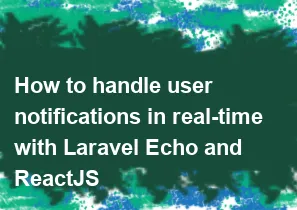How to handle user notifications in real-time with Laravel Echo and ReactJS

Handling user notifications in real-time with Laravel Echo and ReactJS involves setting up a real-time messaging system using Laravel Echo on the server side and integrating it with ReactJS on the client side. Laravel Echo is a powerful tool for handling real-time events, and it's often used with Laravel's broadcasting feature.
Here are the general steps to achieve real-time notifications with Laravel Echo and ReactJS:
Server-Side (Laravel)
Set Up Laravel Broadcasting:
- Make sure you have Laravel Echo and Pusher installed. You can use other broadcasting drivers, but Pusher is commonly used for simplicity.
bashcomposer require pusher/pusher-php-server- Configure your
.envfile with your Pusher credentials.
envBROADCAST_DRIVER=pusher PUSHER_APP_ID=your_app_id PUSHER_APP_KEY=your_app_key PUSHER_APP_SECRET=your_app_secret PUSHER_APP_CLUSTER=your_app_cluster- Configure
broadcasting.phpin theconfigdirectory.
php'connections' => [ 'pusher' => [ 'driver' => 'pusher', 'key' => env('PUSHER_APP_KEY'), 'secret' => env('PUSHER_APP_SECRET'), 'app_id' => env('PUSHER_APP_ID'), 'options' => [ 'cluster' => env('PUSHER_APP_CLUSTER'), 'useTLS' => true, ], ], ],Set Up Broadcasting Events:
- Create an event for your notifications. For example,
NotificationEvent.
bashphp artisan make:event NotificationEvent- Modify the
NotificationEventclass to broadcast your notification data.
phppublic $notification; public function __construct($notification) { $this->notification = $notification; } public function broadcastOn() { return new Channel('notifications'); }- Trigger the event when a notification is created.
phpevent(new NotificationEvent($notification));- Create an event for your notifications. For example,
Client-Side (ReactJS)
Install Laravel Echo and Pusher for React:
bashnpm install --save laravel-echo pusher-jsConfigure Laravel Echo:
- Initialize Echo in your React app, usually in your main
app.jsfile.
javascriptimport Echo from 'laravel-echo'; window.Echo = new Echo({ broadcaster: 'pusher', key: process.env.MIX_PUSHER_APP_KEY, cluster: process.env.MIX_PUSHER_APP_CLUSTER, encrypted: true, });- Initialize Echo in your React app, usually in your main
Listen for Notifications in React Components:
- Use
window.Echoto listen for notifications in your React components.
javascriptimport { useEffect } from 'react'; function NotificationComponent() { useEffect(() => { window.Echo.channel('notifications').listen('NotificationEvent', (data) => { // Handle the incoming notification data console.log(data.notification); }); return () => { // Clean up event listeners if necessary }; }, []); return ( // Your component JSX ); } export default NotificationComponent;- Use
Display Notifications:
- Update your React component to display notifications as they arrive.
Remember to replace the placeholder values in the code snippets with your actual Pusher credentials and event details.
With these steps, your Laravel application will broadcast notifications, and your ReactJS application will listen for these events in real-time, allowing you to handle user notifications efficiently.
-
Popular Post
- How to optimize for Google's About This Result feature for local businesses
- How to implement multi-language support in an Express.js application
- How to handle and optimize for changes in mobile search behavior
- How to handle CORS in a Node.js application
- How to use Vue.js with a UI framework (e.g., Vuetify, Element UI)
- How to configure Laravel Telescope for monitoring and profiling API requests
- How to create a command-line tool using the Commander.js library in Node.js
- How to implement code splitting in a React.js application
- How to use the AWS SDK for Node.js to interact with various AWS services
- How to use the Node.js Stream API for efficient data processing
- How to implement a cookie parser middleware in Node.js
- How to implement WebSockets for real-time communication in React
-
Latest Post
- How to implement a dynamic form with dynamic field styling based on user input in Next.js
- How to create a custom hook for handling user interactions with the browser's device motion in Next.js
- How to create a custom hook for handling user interactions with the browser's battery status in Next.js
- How to implement a dynamic form with dynamic field visibility based on user input in Next.js
- How to implement a dynamic form with real-time collaboration features in Next.js
- How to create a custom hook for handling user interactions with the browser's media devices in Next.js
- How to use the useSWRInfinite hook for paginating data with a custom loading indicator in Next.js
- How to create a custom hook for handling user interactions with the browser's network status in Next.js
- How to create a custom hook for handling user interactions with the browser's location in Next.js
- How to implement a dynamic form with multi-language support in Next.js
- How to create a custom hook for handling user interactions with the browser's ambient light sensor in Next.js
- How to use the useHover hook for creating interactive image zoom effects in Next.js